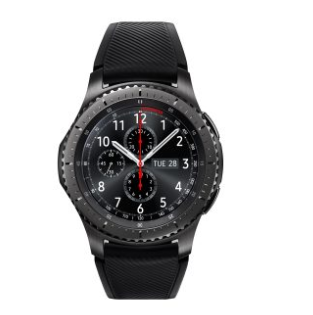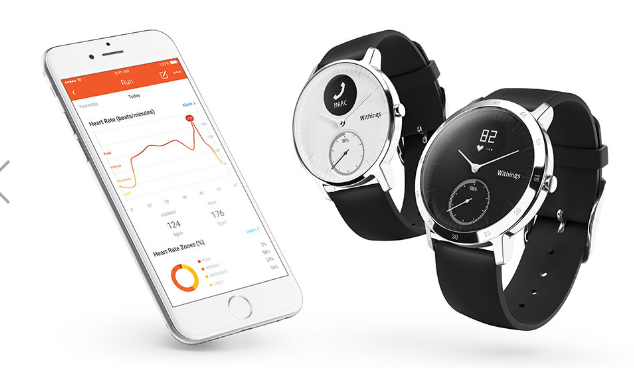
BERLIN — As it did last year, Samsung announced its latest smartwatch at the giant IFA trade show in Berlin and, while they weren’t yet ready to loan me a review unit to fully test, I was able to wear and fiddle with both new S3 models — the “Classic” and the more fully featured “Frontier.”
The first thing I noticed about these watches is that they’re big and quite nice looking. Samsung invested in finer materials than previous versions of its watches along with a more classic design. The company proudly touted its relationship with Swiss watch designer Yvan Arpa, who helped on the project.
The S3 is designed to sync with an Android phone, which doesn’t necessarily have to be from Samsung. There are reports that Samsung may be working on a way to also sync its watches with iPhones, but a Samsung spokesman would only confirm that “we continually evaluate ways to broaden the availability of our wearable devices to more consumers.”
The two S3 models are quite similar. The Frontier is slightly heavier and a bit more rugged looking than the Classic but the big difference is that some versions of the Frontier will come equipped with an optional LTE cellular connection enabling it to stream music and make phone calls even if you don’t have your phone with you.
Both models can connect to a smartphone and be used as a wristwatch phone reminiscent of the “2-way wrist radio” that comic strip detective Dick Tracy wore back in 1946.
Both models have built-in GPS, four gigabytes of storage (for music and other media) and are said to be water and dust resistant. Samsung claims about three days battery life, which is a day longer than last year’s S2 model.
The watches support Samsung Pay, making it possible to make a credit or debit card transaction from most merchants without having to take either a phone or a credit card out of your pocket.
As I mentioned, these are big watches. Both models are 46 mm (1.8 inches) in diameter. Large watches are fashionable but there are plenty of people who would find this watch too big. I suspect that it won’t be popular with women who typically wear smaller watches.
That older Samsung Gear S2 ($249 on Amazon) will remain on the market. I like the S2, as far as smartwatches go, but I have to admit that I rarely wear it, mostly because I often forget to charge it.
Another problem I have with most smartwatches whose screen lights up is that they are hard to read in bright sunlight. The S3 seems to have a brighter display which will help but I suspect that it too can be washed out by direct sunlight.
When I wear a smartwatch, I do pay attention to the notifications if I get a call or a text but I don’t really miss them that much when I’m not wearing the watch. I like the fact that Samsung (and many other) smartwatches can measure my heart rate but — again — it’s not something I fixate on most days. And of course it’s great to know how far you’ve walked but you can also get that information directly from an Android’s Fit app or iPhone’s Health app, even if you’re not wearing a smartwatch.
While Samsung consulted a Swiss watch designer for help with its decidedly electronic device, Fullpower Technologies, a Santa Cruz company headed by technology veteran Philippe Kahn (best known as the inventor of the camera phone) took a different approach. Its MotionX technology brings smart phone capabilities to actual Swiss watches.
I’m wearing a borrowed Alpina watch that looks pretty much like the watches this Swiss company has been making since 1883. It’s a beautiful time piece, which helps explain its hefty ($600 or more) price but what isn’t obvious is that the watch tracks steps and sleep, displays the time in two time zones and can wake you up, not just at an exact time but at the optimal time before your alarm setting, based on your sleep cycle.
All of these functions are controlled by the MotionX app that runs on Android and iPhones. The app also makes sure that the watch is synced with the exact time and allows you to review your steps, calories and sleep data from your phone.
I suppose it’s a combination of jet lag and a busy trade show schedule but last night I got less than six hours of sleep. Two hours were deep sleep, three and a half hours were light sleep and I woke up six times. The good news is that I walked more than 11,000 steps yesterday at the show and around Berlin.
This watch won’t show me who’s calling or texting and it doesn’t measure my heart rate but it does run two years on a replaceable battery, which means that I don’t have to worry about charging it, which is especially important if you’re using the watch to track your sleep, which is when you would typically charge it. But even if I weren’t sleeping with it, I probably would forget to charge it, which is precisely why I’m not wearing the Samsung S2 or any other smartwatch that requires almost daily recharging.
Withings, a French company, was at IFA with its new Steel HR smartwatch that has both analog hands and a digital display to show your continuous heart rate, steps, sleep cycles and notifications. The company claims 25 days battery life on a charge. It’s likely to cost about $200 when it ships later this year.
 Samsung, MotionX and Withings are taking smart but different approaches to smartwatches, but that doesn’t necessarily mean that a smartwatch is a smart purchase for the technologically timid or budget-minded consumer. This product category is young and needs time to mature. And that time will be measured in months and years by a calendar — not in minutes and hours by a watch, smart or otherwise.
Samsung, MotionX and Withings are taking smart but different approaches to smartwatches, but that doesn’t necessarily mean that a smartwatch is a smart purchase for the technologically timid or budget-minded consumer. This product category is young and needs time to mature. And that time will be measured in months and years by a calendar — not in minutes and hours by a watch, smart or otherwise.